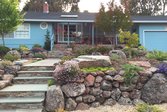
No-water and low-water ideas for a drought-friendly yard.
Drought happens everywhere, not just in the arid climates. So how do you get to have a beautiful, lush, low-maintenance yard that doesn’t need watering when the temps approach triple digits with no rain in site?
Take a cue from homeowners in those arid climates. They know how to survive heat waves. And they’re experts on drought-resistant plants. You’d be surprised how well some of those low-water plants work in less dry conditions. Here’s how to have a yard you need to water less.
Plant Hardy, Drought-Tolerant Plants
Cacti and succulents — the camels of the plant world — are synonymous with Southwest gardening, but turn out to be pretty hardy elsewhere as well. They can add color, flowers, and texture to lawns, while being super drought-friendly.
{{ quote 18 }}
“You don’t want them to have wet feet, though,” Barry Troutman says. Troutman is the technical advisor for the National Association of Landscape Professionals, so he knows his stuff. “They need to be well drained, in open sun with air movement around them.”
He suggests using cholla cacti, which are hardy enough to grow even in Canada, and succulents such as hens and chicks and Parry’s agave.
Seek Native Plants
In the West and Southwest, despite the lack of natural water, yards are still full of color and texture. “There’s a lot of beauty and movement,” says Bales.
Each region has its own native or “adapted plants,” as Troutman prefers to call them.
“People waste water; plants do not,” he points out. “Plants are adapted to protect the water they have.”
Native plants thrive because they are used to the natural state of the region. “You can see these things growing in the wild on their own,” Bales says. “So if you introduce it into your own landscape, it will be more durable.”
A note on newly planted plants: This is when you don’t want to skimp on watering. New plants need more water to help establish strong roots. Those roots will help it acclimate to less and less water as it matures, Troutman says.
Add Some Hardscaping
OK, running barefoot on the lawn is nice, but what about the romantic evening around the fire pit, eating with family and friends in the outdoor kitchen, or soaking up rays on a patio lounge chair?
“In a lot of areas in Texas, lawn sizes are getting reduced and patios are increasing,” Bales says.
More hardscapes — stone walls, gravel paths, paved patios — mean less area that needs to be watered.
And (bonus!), according to the “Remodeling Impact Report: Outdoor Features” from the National Association of REALTORS®, which produces HouseLogic, new patios, outdoor fireplace, and fire pits are among the top-10 projects for appealing to homebuyers and adding value for resale.
But make sure hardscape areas drain into the right places, warns Troutman. “Be careful you don’t create saturated areas where plants can’t grow,” he says.
You may have to call in a professional to make sure hardscape and the adjacent landscape have proper drainage, either by the way the land is sloped or by installing drains in the ground, Bales says.
Related: Landscaping Trends That Save Time and Money
Try the Newest Generation of Fake Grass
“It’s come a long way in how it looks,” says Bales, who has real grass in his front yard and turf in his backyard. “Many brands look and feel like natural grass.”
Bales recommends researching turf products that “hold up well, look good over time, and have a good feel on your bare feet.” Then find a contractor who knows how to install synthetic turf properly.
“What’s underneath it matters,” he says. There needs to be a deep sub-base that’ll last like a concrete patio but allow natural water through.
Troutman cautions that synthetic turf and pavers, if in direct sunlight, can get “really hot and reflect the heat onto your home. It can raise the cost of your air conditioning bill.” He suggests mitigating the heat by creating shaded areas with trees or a pergola.
Replace Plants With (Surprise!) a Water Feature
While that may seem counterintuitive, it makes sense when you think about it. Especially when you consider the newest generation of water features: the pondless water feature.
It’s essentially a waterfall with “a below-ground reservoir covered by rock or stone. The water circulates . . . so it isn’t evaporating, ” says Neil Bales, vice president of Lawns of Dallas.
If you want to stay completely away from water, Bales also suggests getting a water feature look without the water by designing “a dry creek bed with stones that can provide an aesthetic look and be functional in spots where there might otherwise be plants, and the need to irrigate.”
Between the drought-tolerant plants and the hardscaping, you’ll hardly ever water again.



